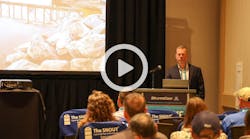About the author: Kurt Kelsey, M.S., CPESC, CPSWQ, is director of technical services for American Excelsior Co. Kelsey can be reached at [email protected].
Erosion control, sediment control and storm water BMPs come in all shapes and sizes. Some tools are flat, some are round, and some take the form of mysterious powders. Perhaps the most important thing to remember about every tool in the BMP toolbox is that they all work better when they are properly installed in the appropriate applications.
It is going on 15 years since I saw my first large-scale erosion control product test. One thing that our industry has learned over the years is that the old saying “you get what you pay for” tends to hold true when talking about erosion control, sediment control and storm water BMPs. Lower-end solutions, such as base hydraulic mulch, may work well on flatter slopes when installed properly, but an additional level of protection in the form of rolled erosion control products may be needed for more severe slope and channelized flow applications. Synergistic BMP combinations can be powerful solutions for even the most challenging requirements.
So how do we put this all together and match the right product to the right application to get the job done successfully the first time? To start, answering the following five basic questions for slope applications can help:
1.How steep is the slope?
2.How long do I need/want the product to last?
3.What is the length of the slope?
4.What is the soil type?
5.Will the slope receive overland flow from above?
For channelized flow applications, providing answers to the following three questions can help:
1.What is the actual design shear stress for the channel?
2.How long do I need/want the product to last?
3.What is the soil type?
In today’s digital age, everything we need should be a mouse click away. Reputable BMPs come from companies that have nothing to hide (including publicly available Safety Data Sheets on all of their products for your protection). Various manufacturers provide free design software programs that help with BMP selection based on your input. Some BMPs come with documented performance capabilities based on ASTM International test standards. Several designers now require ASTM D6459 and D6460 large-scale performance tests for erosion control products before they will consider a BMP for acceptance on the project. In addition, comparing the project design requirements with the documented performance capabilities of available BMPs can be a priceless engineering tool.
BMPs On Beat
We also need to remember that even the best-designed BMP in the world does not work well when it is not installed properly. BMP providers typically have documents explaining how to install their latest and greatest BMPs, but if the contractors who are actually installing the product are not marching to the same drum, we all are off beat. Proper communication and training from start to finish is critical to the success of any project.
Today, we have a plethora of valuable BMPs and data at our fingertips; however, not all BMPs perform at the same level. Following the simple steps discussed above can help match the right product to the right application and lead to more project successes—and maybe even save the owner some money by doing things right the first time.
Download: Here

